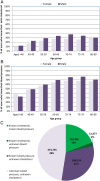Online self-assessment of cardiovascular risk using the Joint British Societies (JBS3)-derived heart age tool: a descriptive study
- PMID: 27683512
- PMCID: PMC5051389
- DOI: 10.1136/bmjopen-2016-011511
Online self-assessment of cardiovascular risk using the Joint British Societies (JBS3)-derived heart age tool: a descriptive study
Abstract
Objective: A modified version of the Joint British Societies (JBS3) 'heart age' tool was introduced online to broaden access to personalised risk assessment to the general population and encourage participation in the National Health Service (NHS) Health Check programme. This study reports on its early uptake and the profiles of those who used the self-assessment tool to determine their own cardiovascular risk.
Design: Observational, retrospective analysis of online tool use.
Setting: Between February and July 2015, user data collected from the NHS Choices website, where the tool was hosted, were analysed anonymously using standard analytic packages.
Results: The online tool landing page was viewed 1.4 million times in the first 5 months, with increased activity following limited media coverage. Of the 575 782 users completing the data journey with a valid 'heart age' result, their demographic and risk factor profiles broadly resembled the population of England, although both younger users and males (60%) were over-represented. Almost 50% and 79% did not know or enter their blood pressure or total cholesterol values, respectively. Estimated heart age was higher than chronological age for 79% of all users, and also for 69% of younger users under 40 years who are at low 10-year risk and not invited for NHS Health Checks.
Conclusions: These data suggest a high level of public interest in self-assessment of cardiovascular risk when an easily understood metric is used, although a large number of users lack awareness of their own risk factors. The heart age tool was accessed by a group not easily reached by conventional approaches yet is at high cardiovascular risk and would benefit most from early and sustained risk reduction. These are both important opportunities for interventions to educate and empower the public to manage better their cardiovascular risk and promote population-level prevention.
Keywords: Cardiovascular Prevention; Cardiovascular Risk; Digital health; Risk factors; Self Assessment.
Published by the BMJ Publishing Group Limited. For permission to use (where not already granted under a licence) please go to http://www.bmj.com/company/products-services/rights-and-licensing/
Figures





References
-
- 2015. IDF Diabetes Atlas—7th Edition. Secondary IDF Diabetes Atlas—7th Edition. http://www.diabetesatlas.org/
-
- Putting Prevention First. Vascular checks: risk assessment and management. London: Department of Health, 2008.
Grants and funding
LinkOut - more resources
Full Text Sources
Other Literature Sources
